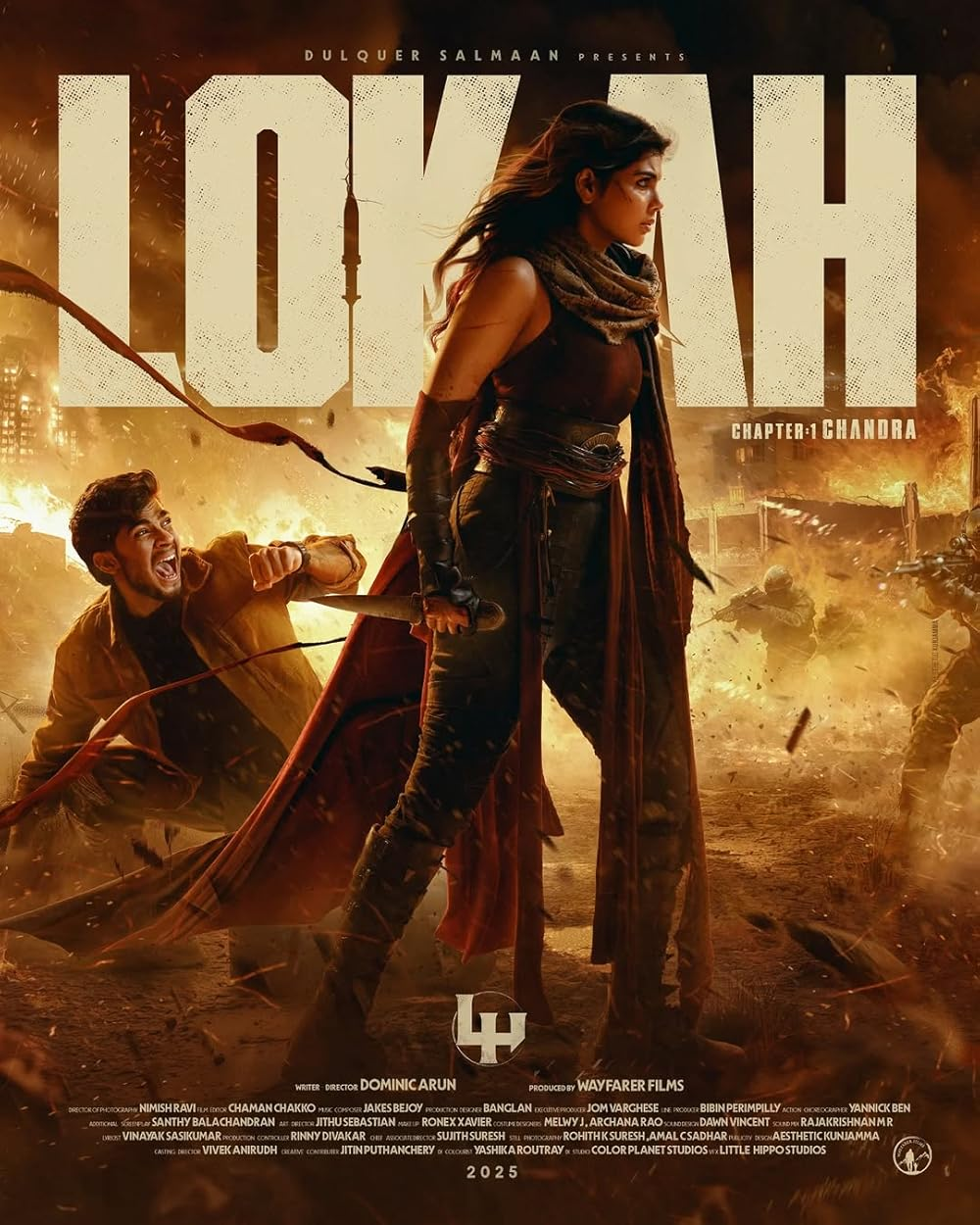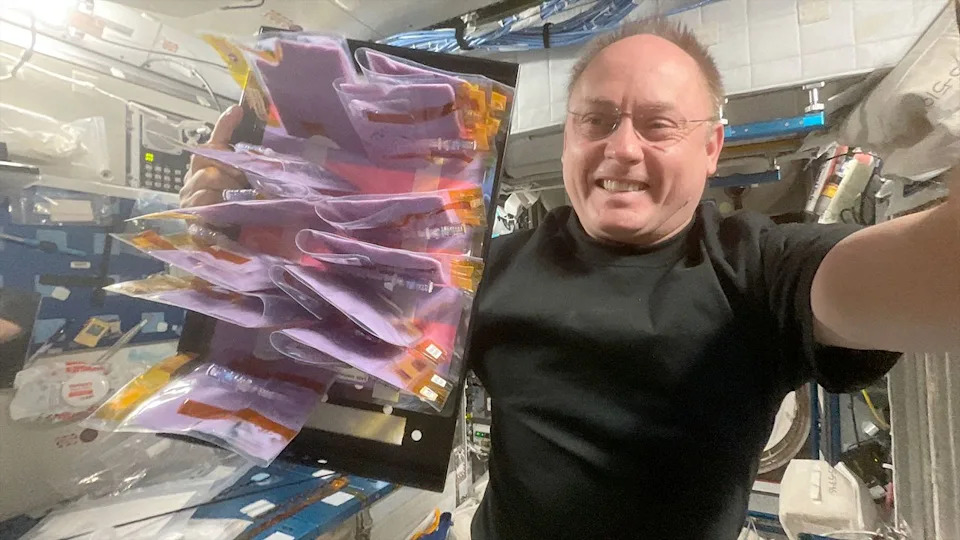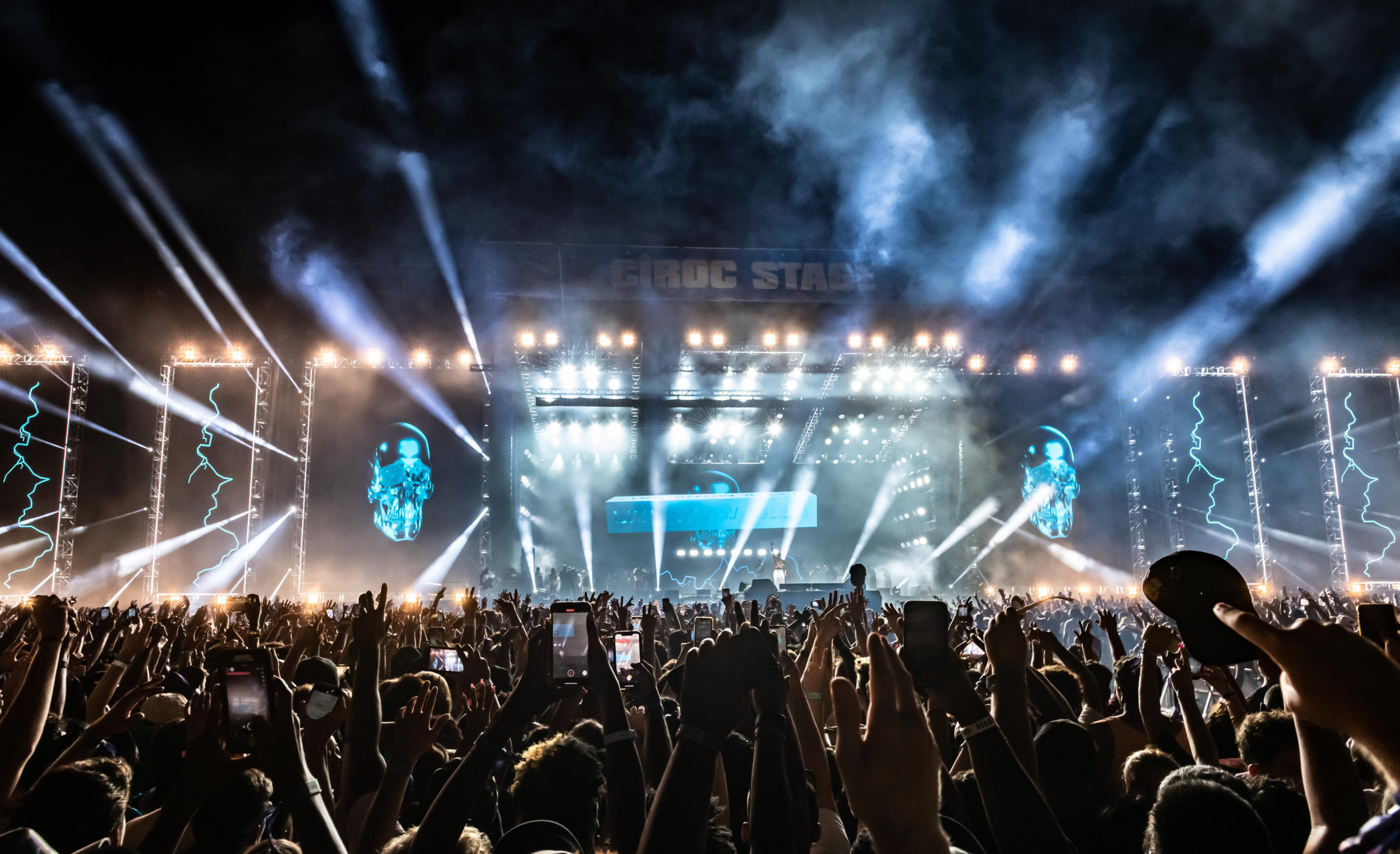The cinematic landscape is perpetually evolving, and with the rise of superhero films across the globe, each new release carries with it not just the promise of entertainment but also a reflection of cultural zeitgeists and societal aspirations. “Lokah Chapter 1: Chandra,” starring the effervescent Kalyani Priyadarshan, has been making waves not only for its gripping narrative and visual spectacle but also for its intriguing box office trajectory as the film reached its eighth day in theaters. The journey of this film’s reception offers a unique lens through which one can examine not only the economics of contemporary cinema but also the subtle interplay between popular culture and wellness in a fast-paced world.
As the film crossed the milestone of day 8 at the box office, reports indicated a steady climb in collections, defying the typical drop-off that many blockbusters experience after the initial weekend surge. This sustained interest speaks volumes about the film’s resonance with its audience, particularly in an era where streaming platforms have challenged traditional theatrical releases. The superhero genre, often characterized by its larger-than-life heroes and complex moral landscapes, has increasingly become a vessel for exploring themes of resilience, identity, and inner strength—elements deeply connected to mental health and personal growth. Kalyani Priyadarshan’s portrayal of Chandra, a character embodying both vulnerability and empowered agency, taps into these universal themes, fostering a connection that transcends mere spectacle.

This intersection of cinema and wellness invites a broader contemplation of how narratives shape our understanding of health—both mental and physical. The superhero archetype, with its emphasis on overcoming adversity, can serve as a metaphor for individual journeys toward well-being. For many viewers, witnessing Chandra’s struggles and triumphs may provide a form of catharsis or inspiration, subtly reinforcing the importance of resilience and self-care. As explored in scholarly discussions like those found in the Journal of Health Psychology, media representations can profoundly influence public perceptions and behaviors related to health, including motivation for fitness, nutrition, and mental health management Journal of Health Psychology.
Moreover, the film’s success at the box office reflects not only the power of storytelling but also the shifting dynamics of habit formation in entertainment consumption. Unlike the binge-watching culture prevalent today, the sustained theatrical attendance for “Lokah Chapter 1: Chandra” suggests a communal and ritualistic experience, one that aligns with broader wellness principles emphasizing routine, social connection, and mindfulness. According to research on habit formation published in the European Journal of Social Psychology, routines that foster social engagement and regularity can enhance mental well-being and longevity European Journal of Social Psychology.

In the context of preventive medicine, the cultural phenomenon around superhero films like “Lokah Chapter 1: Chandra” underscores the importance of narratives that encourage proactive attitudes toward health. When audiences see heroes confronting challenges with courage and care, it subtly endorses a mindset of vigilance and self-improvement, echoing the principles advocated by health experts worldwide. This is particularly relevant in today’s environment, where mental health awareness is gaining momentum, and the stigma surrounding it is gradually eroding. Films that humanize their protagonists and depict their journeys honestly contribute to this positive shift, offering viewers relatable role models and encouraging conversations about emotional and psychological resilience.
As the film continues its theatrical run beyond day 8, it invites us to reflect on the broader implications of storytelling in shaping health behaviors and attitudes. The journey of “Lokah Chapter 1: Chandra” is not merely about box office numbers; it is a testament to the enduring human need for stories that inspire, heal, and connect. In a world where wellness is increasingly recognized as a holistic pursuit encompassing body, mind, and community, such films serve as cultural touchstones that remind us of our shared resilience and the power of narrative to foster hope and transformation.

Ultimately, the success and reception of “Lokah Chapter 1: Chandra” underscore the evolving relationship between entertainment and health. As audiences engage with characters who embody strength and vulnerability, they are invited into a dialogue about their own wellness journeys. This interplay between fiction and reality enriches our understanding of preventive care, mental health, and the importance of nurturing habits that sustain us physically and emotionally. The film’s box office story is but one chapter in a larger narrative about how culture shapes, and is shaped by, the pursuit of a healthier, more mindful life.
Yet, as “Lokah Chapter 1: Chandra” continues its theatrical run beyond the initial surge, its impact reveals layers that transcend mere ticket sales. The film’s nuanced portrayal of a superhero grappling with inner turmoil and societal expectations resonates deeply in an era where mental health dialogues are gaining overdue prominence. Kalyani Priyadarshan’s performance, marked by a compelling blend of vulnerability and strength, invites viewers to reflect on their own battles and the often unseen struggles beneath heroic facades. This alignment between character development and contemporary wellness themes suggests a promising shift in mainstream cinema—one that embraces complexity rather than escapism.
The film’s narrative, steeped in mythological symbolism yet grounded in relatable human experiences, acts as a bridge between tradition and modernity. It beckons audiences to reconsider the archetypes of heroism through the lens of empathy and self-awareness, challenging the conventional binaries of strength and weakness. In doing so, “Lokah Chapter 1: Chandra” taps into a collective yearning for stories that do not just entertain but also educate and empower. This contextual richness may well explain the steady footfall in cinemas, as viewers find themselves drawn not only to the spectacle but to the substance.

Moreover, the film’s reception has sparked conversations beyond the silver screen, with wellness communities and mental health advocates highlighting its potential as a catalyst for awareness and destigmatization. Social media platforms have become spaces where fans dissect scenes, share personal stories, and connect over the universal themes embedded in the film’s fabric. This organic engagement underscores a broader cultural shift where entertainment intersects with advocacy, illustrating how art can be a powerful vehicle for social change.
Looking ahead, the success of “Lokah Chapter 1: Chandra” may influence filmmakers to explore narratives that intertwine health and heroism more deliberately. As audiences increasingly seek content that reflects their lived realities and aspirations for holistic well-being, the industry might witness a renaissance of stories that prioritize psychological depth alongside visual spectacle. The film’s journey thus serves as a beacon, illuminating the path for future projects that aspire to inspire not just admiration but introspection and growth.
In this unfolding dialogue between cinema and wellness, “Lokah Chapter 1: Chandra” stands as a compelling example of how storytelling can nurture the human spirit. It reminds us that heroes are not only those who conquer external foes but also those who navigate the complexities within, offering a narrative mirror that encourages healing and hope. As the box office figures continue to chart the film’s commercial trajectory, the true measure of its success may well lie in the hearts it touches and the conversations it ignites across communities worldwide.
The film’s resonance with audiences also highlights a fascinating evolution in the superhero genre itself, which has traditionally been dominated by tales of physical prowess and external battles. “Lokah Chapter 1: Chandra” shifts this paradigm by centering its protagonist’s internal struggles and mental fortitude, thereby expanding the definition of heroism in contemporary cinema. This nuanced portrayal invites viewers to contemplate the often invisible battles many face daily, fostering empathy and a deeper understanding of mental health challenges. Moreover, Kalyani Priyadarshan’s compelling performance breathes life into this complex narrative, her portrayal striking a delicate balance between vulnerability and strength that anchors the film’s emotional core.
The box office success, while notable, is only one facet of the film’s impact. The conversations it sparks in academic circles, mental health forums, and community groups underscore its broader societal relevance. By embedding wellness themes within a commercially viable format, “Lokah Chapter 1: Chandra” bridges the gap between entertainment and education, making critical topics accessible without sacrificing narrative engagement. This approach could signal a shift in how filmmakers address taboo or stigmatized subjects, leveraging the mass appeal of genre cinema to foster awareness and dialogue.

However, the film has not been without its critics. Some argue that the blend of superhero spectacle with psychological drama risks diluting the impact of both elements, potentially alienating purists from either camp. Others contend that while the film’s intentions are commendable, the execution sometimes falters under the weight of its ambitious themes, leading to moments where pacing and narrative coherence are sacrificed. These critiques open an important conversation about the challenges of innovating within a well-trodden genre and the delicate balance required to satisfy diverse audience expectations.
Looking to the future, the filmmakers behind “Lokah Chapter 1: Chandra” have expressed interest in expanding the universe they’ve created, hinting at subsequent chapters that delve deeper into the mythology and character arcs introduced here. This serialized storytelling model echoes the frameworks popularized by major franchises but with a distinctly introspective and culturally grounded sensibility. If successful, it could inspire a new wave of Indian superhero cinema that prioritizes character complexity and social relevance over mere spectacle, potentially reshaping the genre’s landscape both domestically and internationally.
As streaming platforms continue to democratize access to diverse narratives, films like “Lokah Chapter 1: Chandra” stand to reach even wider audiences beyond the constraints of theatrical runs. This extended lifespan offers opportunities for sustained engagement, critical reevaluation, and community building around shared themes of resilience and mental health. The film’s journey from box office contender to cultural touchstone exemplifies how cinema can evolve into a participatory experience, where viewers are not just passive consumers but active contributors to an ongoing dialogue about what it means to be a hero in today’s world.
Yet, despite these ambitious narrative goals and the potential for a franchise that challenges the norms of superhero storytelling, the box office numbers on day 8 suggest a complex reality. While “Lokah Chapter 1: Chandra” has maintained a respectable hold, particularly in urban centers where audiences are more receptive to nuanced storytelling, the broader commercial appeal remains uneven. This disparity underscores the ongoing tension between artistic innovation and market viability—a familiar battleground for Indian cinema, where commercial success often hinges on balancing mass entertainment with thematic depth. Kalyani Priyadarshan’s portrayal of Chandra has been widely praised for bringing a layered vulnerability to the superhero archetype, which resonates with viewers craving representation beyond the traditional macho hero. However, this very deviation from formulaic expectations may also contribute to the film’s polarized reception among audiences accustomed to more conventional fare.
The cultural context cannot be overstated here. Indian superhero cinema is still in a nascent stage compared to Hollywood’s decades-long evolution, and audiences are navigating new terrain where myth, modernity, and social issues intersect. The film’s emphasis on mental health, a topic often stigmatized or overlooked in mainstream Indian media, adds a layer of social commentary that enriches the narrative but may also challenge viewers seeking escapism. This duality is reflected in the diverse critical responses, ranging from admiration for its bold thematic choices to frustration over pacing and narrative clarity. It is within this dynamic that “Lokah Chapter 1: Chandra” carves its niche, signaling a shift not just in the stories being told but in how Indian cinema is willing to engage with its audience on complex, often uncomfortable issues.
Looking ahead, the trajectory of “Lokah” as a series will likely depend on how effectively the filmmakers can navigate these challenges. The next chapters have the potential to deepen the world-building and address some of the narrative critiques through more focused storytelling and character development. Moreover, the increasing collaboration between regional cinema and pan-Indian platforms could provide the necessary infrastructure and audience base to support such ambitious projects. This cross-pollination is already visible in other Indian superhero ventures that blend local mythologies with contemporary issues, suggesting a fertile ground for “Lokah” to expand its influence.
In the broader scheme, “Lokah Chapter 1: Chandra” represents a pivotal moment in Indian cinema’s ongoing dialogue with genre conventions and cultural narratives. Its box office performance on day 8 may not fully capture the film’s potential impact, which could unfold over time through digital platforms, fan communities, and critical discourse. As the superhero genre continues to evolve globally, films like “Lokah” remind us that the power of cinema lies not only in spectacle but in its ability to reflect and shape societal values, offering new heroes who embody the complexities of the world we live in.
Yet, beyond the numbers that the box office tally provides, the emotional and cultural resonance of “Lokah Chapter 1: Chandra” reveals itself in the conversations it sparks among viewers. Kalyani Priyadarshan’s portrayal of Chandra—a superheroine who grapples with identity, duty, and the shadows of her past—has invited discussions about the representation of women in Indian superhero narratives, an area historically dominated by male protagonists. This shift is subtle but significant; it challenges entrenched cinematic tropes and opens space for stories that resonate with a broader demographic, particularly young women who see in Chandra a reflection of their own struggles and aspirations. The film’s layered approach to heroism—eschewing invincibility for vulnerability—adds a refreshing depth, making it more than just a spectacle but a narrative that encourages empathy and introspection.
Moreover, the film’s aesthetic choices, from its moody cinematography to its intricate costume design, contribute to an immersive experience that distinguishes it from typical superhero fare. The urban landscapes of the film, tinged with a futuristic yet familiar ambiance, echo the duality of Chandra’s character: grounded yet otherworldly. This visual language, paired with a haunting score, weaves a tapestry that feels both intimate and epic, inviting viewers to invest emotionally in the unfolding saga. It’s this blend of style and substance that has cultivated a dedicated fanbase, eager for the next installments to explore the moral ambiguities and societal challenges hinted at in this chapter.

However, the journey ahead for “Lokah” is not without its hurdles. The superhero genre, while increasingly popular in Indian cinema, still contends with the challenge of balancing commercial viability with artistic ambition. The film’s moderate box office performance on day 8 suggests a cautious reception, possibly indicating that audiences are still calibrating their expectations for a distinctly Indian superhero narrative that diverges from the formulaic. Yet, this very tension can serve as a crucible for innovation, pushing filmmakers to refine their storytelling and marketing strategies. The success of subsequent chapters may well hinge on how effectively they engage with both the core fanbase and the wider audience, leveraging digital platforms and social media communities to sustain interest beyond theatrical releases.
In a broader cultural context, “Lokah Chapter 1: Chandra” arrives at a moment when Indian cinema is increasingly embracing genre hybridity—melding mythology, folklore, and contemporary socio-political commentary. This evolution reflects a society in flux, grappling with rapid modernization and the preservation of cultural identity. Films like “Lokah” function as cultural artifacts, capturing this dynamic interplay and offering narratives that resonate on multiple levels. As such, the film’s journey from box office numbers to critical acclaim and cultural impact will be fascinating to observe, especially as it navigates the complex terrain of Indian popular culture and global cinematic trends.



